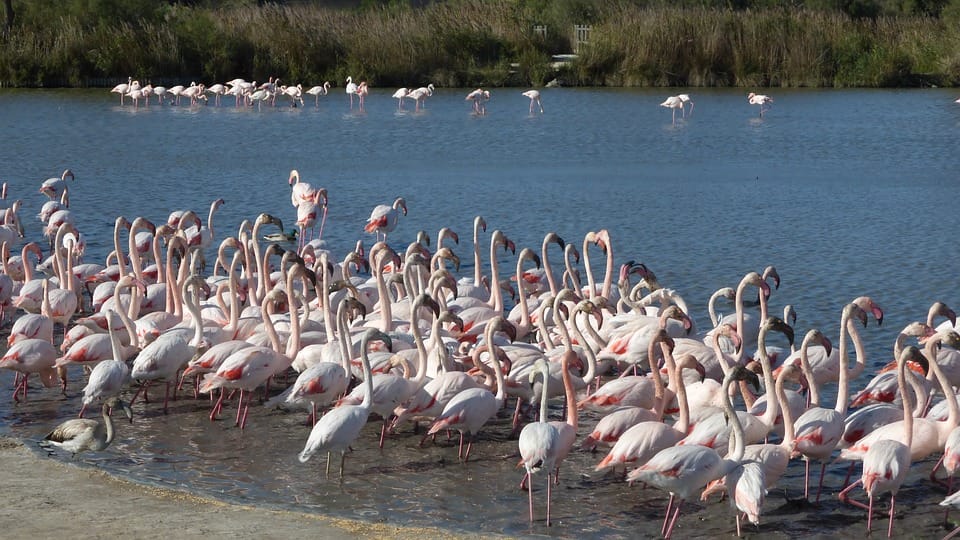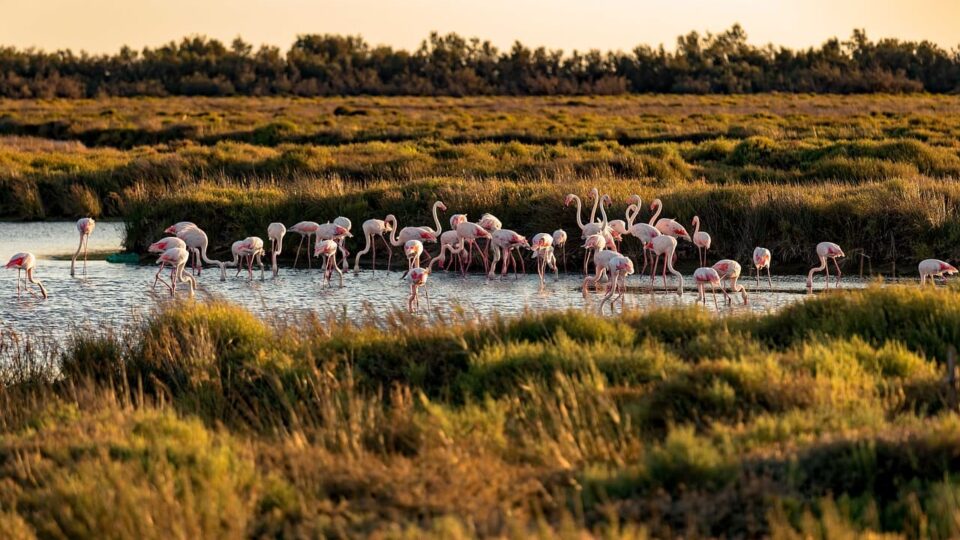Is Camargue Worth It?
Camargue is a nature park with a wealth of cultural heritage. It is famous for its immense beauty and wildlife. At the same time, the area is located in the Mediterranean, it courses over three towns, including Port-Saint-Louis-du-Rhone, Arles, and Saintes-Maries-de-la-Mer. The park has an impressive number of flamingos, breeding bulls, wild horses, and a great collection of birds.
For wildlife and nature enthusiasts, the Camargue Nature Park is the ideal destination. The park is another reason to visit the beautiful city of Arles.
>>Also Read: What is Camargue Famous For?
Here Are Some Things Worth Doing In and Around Camargue:
Catch Some French Bullfighting Show
Camargue is famed for bullfighting, among other things. The Spaniards are not the only ones good at bullfighting. But unlike in their country, a matador is absent, and the bulls are not killed. In Camargue, the bulls are adored as visitors will find pictures of the favorite bulls in stalls and restaurants in different parts of the region.
Bullfighting is a competition of strength and agility. It is performed on occasion, and men dressed in all white attempt to remove trophies (often tassels or rosettes) from between the bull’s horns. Also different in Spain, bullfighting matches take place every week in the summer. It is also made a carnival-like event as the competitions move from one village to another.
Watch the Beautiful White Horses
White horses are a special breed that is believed to be the world’s oldest. These animals are so important to Camargue that they have become a distinguishing style for the nature park. While some of the white horses are almost wild, many of them are used by the local cowboys for herding and rounding up the black bulls. Camargue visitors can also ride the popular white horses as there are many stables across the area that offer riding opportunities to tourists. When you ride on horseback, it is a great chance to explore the marshes and walk across the fields.
See the Squawking Pink Flamingos
This briny wetland is where two parts of the Rhone link the sea to constitute the largest Mediterranean delta just after the Nile River. Camargue is a bird’s heaven with more than 340 species (one of the most popular is the pink flamingo).
A program was developed in the 1970s to guard flamingos in the area. An artificial island called l’étang du Fangassie was created to foster a breeding program. It was successful, with 10-15000 couples reproducing yearly. If you are keenly interested, there are guided tours available in the spring and summer months.

Adore the Camargue Cross
Different from a Latin cross. This is peculiar to Camargue with three virtues melded into a single symbol:
- The cross of faith- bearing a three-pronged fork used by the cowboys (gardians)
- The heart of charity
- The anchor for hope
In Provencal terms, this cross is not quite old. Sculptor Hermann Paul developed it in 1924 as a commission for Marquis of Baroncelli.
Take a Salt Tour of the Camargue
Along with its bulls and horses, salt production is also a major focus in the Camargue. The best views of the brilliant pastel-colored saltpans are in the South of the village of Sallin de Giraud. For those looking to see more of the place, Salins du Midi salt company in Aigues-Mortes offers tours. Every year, the company makes 500,000 tonnes of salt.
Cruise on the Camargue’s Canals
The Camargue traverses canals- coursing into the Mediterranean Sea. One of the best ways to take on this area of the country is to explore the canals on a houseboat. With just a few canal locks and no experience required, any traveler can go to the Camargue on a boating expedition.
With a brief lesson on how to sail, and how to prepare your houseboat, you will be good to cruise the canal comfortably. This is one of the few great ways to enjoy this part of France. France’s sunniest area is the Camargue, and it has over 300 days of sunshine every year. While the boat moves, you can soak up the sunshine and take in the view as you should. Villages with twits of Medieval vineyards, alleys, nature reserves, and walled crusader towns will be waiting ashore for you. These are accessible by bicycle or foot from each port.
Witness the Beauty of Beaucaire
Although it is technically not part of the Camargue, Beaucaire is only north and worth multiple visits for its beguiling labyrinth of crumbling castles and medieval alleys. This castle overlooks Provence and the Rhone River.
The present form was built in the 1100s and 1500s on the top of the Roman framework that was pulled down by the declaration of the Cardinal de Richelieu. Visitors will see a petit museum on the castle grounds. The museum states the story of Beaucaire from its ancient Roman times and the Middle Ages when the town used to host a great fair.
While the rest of the town is less brisk, it is sure worth a walk through its street to adore the mansions. Watch out for Le Drac and his son, which are from a popular French legend that Gervase of Tilbury penned in the 1200s. As the story goes, a woman was kidnapped by Le Drac. She was doing her laundry in the Rhone before she was dragged to the bottom of the river and coerced to be Le Drac’s son’s nanny.
Seven years later, she returned to her husband, unharmed. It was said that Le Drac should shapeshift into a human body, and while the woman was walking one day, he appeared to her. It appeared he could not conceal his disguise enough. Hence, the woman recognized him despite his new body, and he returned to the belly of the river forever.
Dine at the canal side of the Quay. Then proceed to Restaurant Le Soleil and indulge their seafood and fish. The mussels and French fries (moules frites) are particularly big. Also, bicycles are useful here. You should be able to ride the few kilometers to Mas des Tourelles- the most distinct winery you will taste in the area.

Embark on a Roman Winetasting at Mas des Tourelles
This place has not stopped the production of three Roman wine recipes in the ancient method with the use of the same press and fermentation techniques that have been used in ancient Roman times. About 10,000 bottles of Roman wines are manufactured here every year. It even observes a festival for the grape harvest too.
One of the exciting things to do at Mas des Tourelles is to figure out the difference between modern wine and ancient Roman wine. Visitors will come across mulsum. This is a wine with honey, made from the red Grenache grape with red pepper, ginger, thyme, cinnamon, and honey. In ancient times, it served as a great antiseptic. The rich also drink it with ice.
Try out Turriculae too. This is another interesting wine to have. Though it is easy on the nose as it smells sweet, it is made with defrutum (a grape juice syrup), seawater, and curry. And on the palette, it even tastes salty. This happens to be the only exact Roman wine recipe found and manufactured today.
You can round off your Roman wine tasting tour with Carenum (a sweet wine). It is made from white Grenache grape and with the addition of a sizable quantity of defrutum. The Roman wines that Mas des Tourelles produce can be kept for as long as 4-5 years before drinking.
Fix your Wine Craving at Chateau Mourgues du Gres
Not far from Mas des Tourelles, the Chateau Mourgues du Gres affords the chance to taste more modern wine. It is a winery located in the heart of fruit orchards in the charming countryside. Beyond a winery, Chateau Mourgues du Gres is an experience that only wine lovers will come to appreciate. Visitors will find lots of hiking pathways throughout the vineyards. They can request a picnic lunch for the hike or just stay in the winery apartment.
Alternatively, you can stop by for a shorter visit that features a walk through the vineyards and indulge in a wine tasting of the varieties here. Do not forget to get a few bottles as souvenirs or for your return trip on the cruise.
Is Camargue Worth It? – Summary
Proceed south of the historic city of Arles in southern France, and you will see the ravishing natural park of the Camargue. From the gallant white horses, the emblematic pink flamingos, to the salt of the Camargue, there is always something to hold your attention. A visit to Camargue is definitely worth your time.
